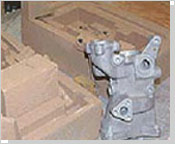 It's the science of making an original pattern or form which will be used to
make a mold. The mold will allow for mass production of the original pattern
by poring some sort of casting material such as metal, resin, plaster, or
other material. A pattern can be both simple and complex for e.g an object
that has detail on only one side like a plaque, or with detail on all sides,
like a machine part. Factors that go into making a pattern includes
durability, shrinkage, machine allowances, draft and undercuts.
It's the science of making an original pattern or form which will be used to
make a mold. The mold will allow for mass production of the original pattern
by poring some sort of casting material such as metal, resin, plaster, or
other material. A pattern can be both simple and complex for e.g an object
that has detail on only one side like a plaque, or with detail on all sides,
like a machine part. Factors that go into making a pattern includes
durability, shrinkage, machine allowances, draft and undercuts.
In sand casting, the pattern is usually of wood, whereas it may be of metal or other materials in pressure or centrifugal casting. The patternmaker also decides where the sprues and risers (inlet and outlet for molten material) will be placed with respect to the pattern. Objects which have holes or depressions in some of its parts are taken care of by inserting cores. Sometimes patterns may also contain chills, solid pieces of the final material, to enable rapid cooling, resulting in quench hardening in the neighborhood of the chill.
As sand casting methods have paved the way for die casting and thin mold casting (the mold is made of a thin, workable refractory material), patterns are not much in use today, though they may still be used for small or specialized jobs.
